Photonics is revolutionizing satellite communication, Earth observation, miniaturization, and precision navigation in the space industry, especially for nano-satellite constellations.
JEREMY PICOT-CLEMENTE, EUROPEAN PHOTONICS INDUSTRY CONSORTIUM (EPIC)
New Space, a vibrant and rapidly growing domain that encapsulates private space exploration, satellite deployment, and cutting-edge space technologies, is in the midst of a breathtaking wave of advancements. Photonics has stepped into the spotlight of this fascinating epoch as a pivotal catalyst, where it is fueling new capabilities and prospects for New Space applications as diverse as communication, navigation, sensing, and even propulsion. Photonics technology enables the miniaturization of space instruments, more precise navigation systems, high-speed free-space data transfer, and advanced imaging and sensing technologies for Earth observation.
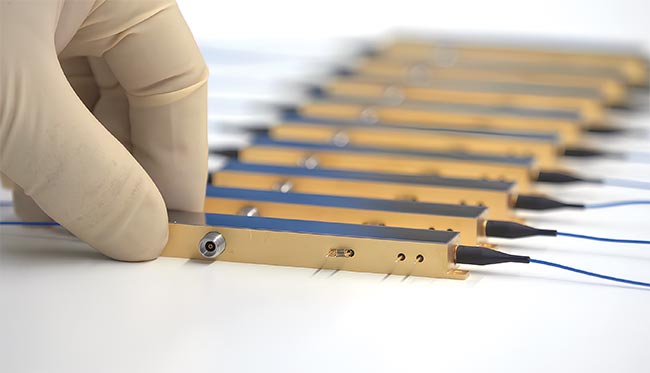
The reliability of Exail’s lithium niobate (LiNbO3)-based modulators comes from the company’s core expertise in fiber-optic gyroscopes, some of which have clocked more than 6 million hours in orbit on more than 30 satellites without incident. Courtesy of Exail.
Research and Markets’ Global Space Economy Market Report 2022-2026 provides an intriguing look into the financial trajectory of the space industry. As of 2021, the worldwide space market already held a stellar value of $388.5 billion. But it is projected to rocket to $540.8 billion by 2026, charting a compound annual growth rate of 6.8%. Analysts speculate that with the continual decrease in launch costs, the space industry will reach $1 trillion in annual revenue by the year 2040. As space becomes less costly to access, the gateway to expansion and innovation widens significantly.
A host of factors are propelling this growth: The rising excitement around space tourism, the increasing demand for uninterrupted internet connectivity, the novel concept of space resource utilization, and the burgeoning number of small satellites and micro-launch operations are all stoking the industry’s fire. Additionally, the evolution of in-space manufacturing, the technological strides in asteroid mining, and the escalating demand for payload and telemetry data are thrusting the industry forward. And the expanding interplay between space and climate change along with the surging demand for Earth observation data is not to be overlooked. All these factors are fueling this remarkable new industry into the cosmic financial stratosphere.
Satellites set the stage
The Union of Concerned Scientists reports a fascinating statistic: As of the beginning of 2023, our planet has been encircled by 6718 operational satellites, which constitute a substantial 67.3% of all objects in Earth’s orbit. Of these objects, a significant 78% were reported as being commercially used, reflecting the influence of the burgeoning commercial broadband sector. The global appetite for bandwidth has stimulated several broadband companies to deploy vast fleets of satellites, most of which are interconnected via free-space optical systems.
A prime exemplar of this trend is Starlink, a satellite constellation orchestrated by SpaceX. The curtain rose on the Starlink project in 2019 with an ambitious objective: to provide internet access to more than 60 countries and extend a global mobile phone service. As of May 2023, the Starlink constellation includes more than 4000 mass-produced small satellites stationed in low Earth orbit and exchanging data with designated ground transceivers. SpaceX’s long-term plan foresees the deployment of nearly 12,000 satellites, with a potential expansion to 42,000. The company announced that it had surpassed the milestone of 1 million subscribers in December 2022 before soaring to 1.5 million by May 2023.
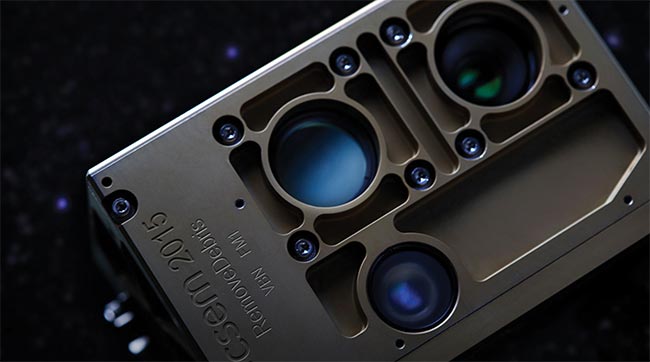
Terrestrial photonic technology has had decades to refine itself to enable more compact, reliable, and power-efficient solutions for the harsh space environment. Organizations, including the Swiss Center for Electronics and Microtechnology (CSEM), built on its expertise in terrestrial applications to develop space-qualified solutions, such as the vision-based navigation sensor it provided to the Remove-DEBRIS mission led by Surrey Space Centre in the U.K. Courtesy of CSEM.
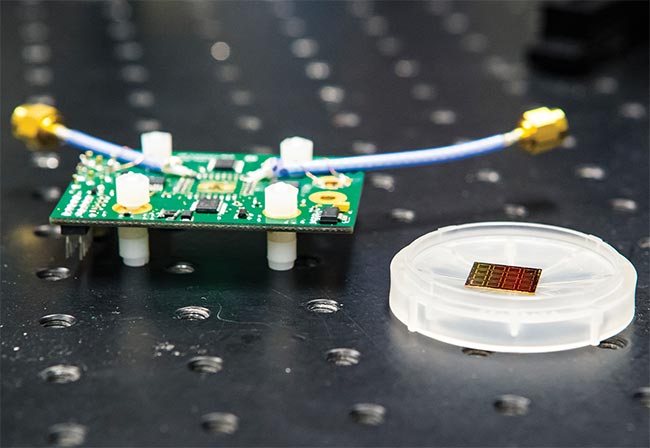
Sweden’s RISE Institute developed an electro-absorption modulator that exhibits low weight and power for space-based free-space optical communication terminals. Courtesy of RISE Institute.
Hot on Starlink’s heels, Amazon has sketched out its blueprint to launch 3236 satellites across three distinct orbits at 605 km, 610 km, and 630 km above Earth. Its goal is to deliver low-latency, high-speed broadband connectivity to communities around the world who are currently underserved or entirely unserved, thereby enveloping ~95% of the world’s population within its coverage. Amazon anticipates half of its satellites will be operational by 2026, with the remainder poised for deployment by 2029.
Meanwhile, the Chinese government is not sitting idle. They are laying the groundwork for a formidable, national constellation consisting of 13,000 satellites. The race for orbit, it seems, is just beginning.
The deployment of photonics in space is marked by unique challenges in contrast to terrestrial developments. When it comes to space, the demand is heightened for low power consumption, radiation tolerance, robustness, environmental adaptability, and most importantly, unerring reliability. Photonics manufacturers are bracing for the engineering solutions needed to conquer these towering challenges.
Laser components and systems
First-generation Starlink satellites relied exclusively on traditional radio-frequency communication for intersatellite communication, but more recent iterations use lasers. This offers several advantages. First, transmission speeds are faster, and bandwidth is much larger due to a more precise control of the laser beam. Second, by enabling communications from one satellite to another on the same or adjacent orbital plane, a ground station does not need to be in the same satellite footprint as user terminals. Laser crosslinks can also lower latency because they reduce the number of hops a signal makes between satellites and ground stations. For intersatellite laser communications, the 1064-nm wavelength is frequently used because it allows longer transmission distances and less atmospheric interference.
Lasers are also used for intrasatellite communication (i.e., the exchange of information between different subsystems within a single satellite). For these appli-
cations, 850-nm laser diodes are more commonly used because they help reduce size, weight, and costs.
As the cost of space launches nosedive and New Space enterprises bloom, the vast expanses of the cosmos seem increasingly within our reach. Looking ahead, key players, such as the European Space Agency (ESA) and NASA, are shifting gears to adopt a fresh paradigm: space logistics. Whether repairing, refueling, recommissioning, or repositioning spacecraft, such intricate operations require precise docking. To facilitate this, the Swiss Center for Electronics and Microtechnology (CSEM) is at the helm of pioneering initiatives to develop lidar and sensor platforms tailored for in-orbit servicing. The objective is to offer cost-effective, intelligent, and easily integrated sensors that bolster close-range navigation and robotic maneuvering in orbit.
Addressing complex challenges such as miniaturizing laser emitters for flash lidar, fortifying high-performance digital processors against the rigors of space, and crafting pose estimation algorithms, CSEM capitalizes on its background in time-of-flight lidar. Its expertise, honed during terrestrial endeavors such as the AIRSWIM bathymetric lidar system, is now addressing new challenges in space, such as development of the vision-based navigation sensor for the RemoveDEBRIS mission led by Surrey Space Centre in the U.K.
An optical transceiver comprises a transmitter and a receiver to send and receive digital and optical signals. Though these devices are commonly used in terrestrial fiber networks, they are finding increasing application in both inter- and intrasatellite communications in harsh space environments.
MBRYONICS, based in Ireland, developed its ultralow power silicon photonics TeraBIX transceiver for high-speed 56 Gb/s per channel serial links onboard satellites. The device combines co-packaged optics for reduced size, weight, and power with radiation-hardened electronics, accommodating two key parameters for intrasatellite communications.
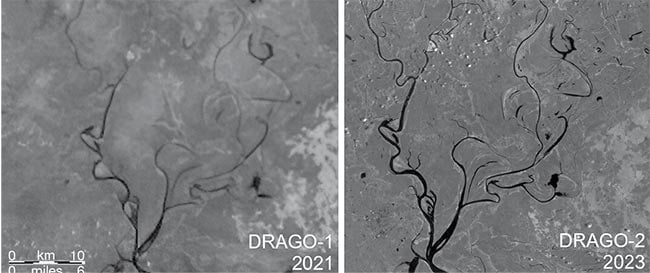
A key milestone for ASE Optics was its design and development of a SWIR optical system for the DRAGO-2 mission, launched by the Instituto de Astrofísica de Canarias (IAC) IACTEC-Space program. The optical system notably improved DRAGO-2’s image quality as compared here to its predecessor’s. The image captures an area of eastern Bangladesh. Courtesy of ASE Optics.
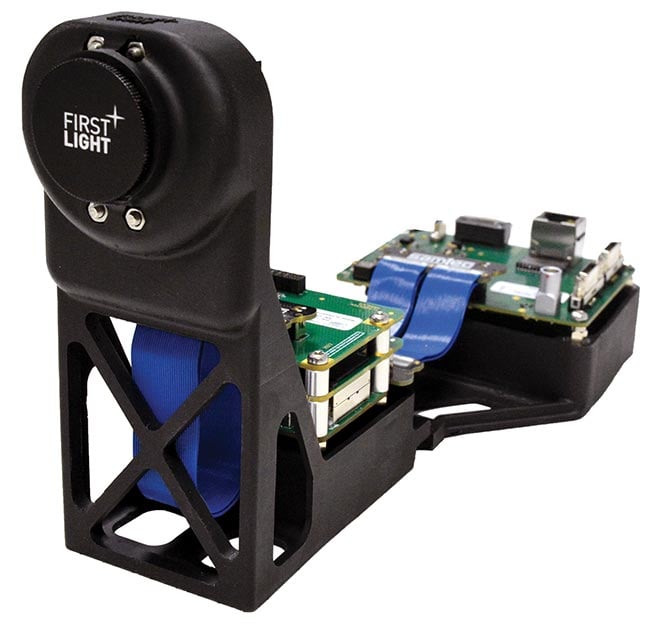
France’s First Light Imaging specializes in visible and infrared scientific cameras for wavefront sensing and astronomy. The company offers off-the-shelf and customizable SWIR camera solutions for applications ranging from high-speed laser beam detection for free-space optical communication and beacon beam tracking to Earth observation and greenhouse gas detection. Courtesy of First Light Imaging.
The company is also addressing the challenge of optical connectivity in space through StarCom, its optical terminal
solution for feeder- and intersatellite links.
Optical modulators
Advanced optical modulators are also essential for high-speed space communications. France-based Exail specializes in the manufacture of lithium niobate (LiNbO3)-based modulators designed for space applications. The reliability of its modulation devices comes from the company’s core expertise in fiber-optic gyroscopes based on optical fiber coils and an in-house developed phase modulation solution. For more than 20 years, Exail has been partnering with Airbus Defense & Space for the delivery of its Astrix fiber-optic gyroscope technology, which has clocked more than 6 million hours in orbit on more than 30 satellites without incident.
Other space-grade components and subcomponents offered by Exail include radiation-hardened fibers with matching
fiber Bragg gratings, fiber sources, low-noise optical amplifiers, multiplexer/demultiplexers, and other micro-optics assemblies.
The optical transceiver developed by the company in close collaboration with Airbus Defense & Space is made of a compact optical channel emitter that integrates Exail’s LiNbO3 modulator and radio frequency amplifier. Several optical channel emitters can be multiplexed and the reception channel integrates the proprietary low-noise optical fiber.
RISE, an independent, state-owned
research institute based in Sweden, helps to develop technologies, products,
services, and processes that contribute
to a more sustainable world and competitive industry in collaboration with and
on behalf of academia and the private
and public sectors. Among its projects, RISE is developing a modulating retro
reflector that exhibits low weight and power for potential use in a mobile
terminal in an asymmetric free-space optical communication link. In such systems, most of the power, weight, and pointing requirements can be arranged at another end of the link. RISE’s electro-absorption modulator-based device employs operating wavelengths, such as 850 or 1550 nm, and has been delivered to customers and partners worldwide for space, defense, civil, and industrial
applications. Moreover, they have achieved data links of 500 Mbps between a flying unmanned aerial vehicle and a ground station at a range of 560 m by using a 6 × 6 enterprise asset management array.
Optical components
The space industry’s rapid technological advancements have helped decrease the cost to launch satellites into low Earth orbits. This has compelled more telecom providers to consider broader reliance
on constellations of interconnected
satellites able to provide redundancy in case of satellite failures or outages. Adapting the coherent optical technology used in terrestrial fiber links to space-based environments is crucial to enable satellite networks to deliver improved data rates, higher sensitivities, and better signal-to-noise ratios. Integrated photonics technology will be key to allowing these coherent systems to drastically reduce their size, weight, and power specifications.
Furthermore, by leveraging electronics assembly and packaging schemes designed for the space sector, the photonics industry can develop coherent systems with the ruggedness required to operate in space. EFFECT Photonics is one such photonics supplier that is developing highly vertically integrated solutions that address the need for high-performance, affordable solutions targeting the ever-increasing demand for bandwidth, and faster data transfer capabilities.
Optical filters provide wavelength selectivity to the instruments that are
essential for both satellite communications and Earth observation applications.
In the latter application, specific
wavelength bands are often necessary to allow observation of unique spectral characteristics representative of particular phenomena of interest, ranging from weather patterns to environmental monitoring to agricultural interests.
For intersatellite communication,
optical filters provide wavelength selectivity for functions, such as solar rejection windows or signal refinement, or dichroic filters for splitting or combining laser beams. Solar Rejection Windows allow communication between satellites within the 1550-nm band while blocking background solar radiation to provide improved signal-to-noise and minimize solar heating inside the satellite.
Canadian-based Iridian Spectral Technologies has developed a range of optical filters, including single bandpass filters
to interrogate one wavelength region as well as multi-zone filter arrays that can turn a single detector into a multispectral device capable of analyzing different wavelengths. In order for these filters to be cost-effective, they must deliver minimal size, weight, and power requirements. But they must also be robust and reliable enough to qualify for use in orbital
applications. Iridian has provided custom optical filters for space agency projects, such as the recently launched ESA
MeteoSat Third-Generation Lighting Imager.
Earth observation
Earth observation is one of the fastest-growing sectors in New Space, with emerging applications in agriculture, environmental monitoring, and the observation of natural phenomena.
For example, Barcelona-based ASE Optics Europe is developing compact optical solutions for remote sensing platforms on small satellites and Cubesats. The satellites enable precision farming by facilitating personalized irrigation recommendations through spectral imaging.
A key milestone for ASE Optics was its design and development of a SWIR optical system for the DRAGO-2 mission launched by the Instituto de Astrofísica de Canarias (IAC) IACTEC-Space program. The optical system notably improved the mission’s image quality, allowing the distinction of many different natural phenomena.
Another company working on Earth observation solutions for New Space applications is the French company First Light Imaging, which has more than
10 years of expertise as a specialist in
visible and infrared scientific cameras
for wavefront sensing and astronomy.
The company offers off-the-shelf and customizable SWIR camera solutions
for optical payloads. Based on space-
qualified sensors and electronics, First Light Imaging’s solutions can address
applications ranging from high-speed laser beam detection for free-space optical communication and beacon beam tracking to Earth observation and greenhouse gas detection. First Light Imaging offers a high level of customization on its hardware, its electronic designs, and its firmware.
Headquartered in Belgium, IMEC (Interuniversity Microelectronics Centre) is a leading R&D organization for CMOS-based technologies targeting applications in biology, industry, consumer, and space applications. Its solutions encompass integrated photonics, imaging, and advanced electronics. With regard to integrated photonics and flat optics, IMEC has worked on ESA projects calling for compact, reliable, and low-power laser communication links. IMEC also develops CMOS-compatible solutions and cameras for hyperspectral imaging used on Earth observation satellites.
Future challenges
In the immediate aftermath of Russia’s invasion of Ukraine, SpaceX swiftly
deployed Starlink terminals to the embattled country. Presently, more than 5000 terminals are in operation, serving as vital lifelines for government bodies
and critical infrastructure. Amid the fierce clashes, Starlink often represents the last strand of communication with the wider world to ensure data transmission continues swiftly and reliably.
Starlink’s extensive use on the battlefield, however, raises pertinent questions regarding its potential vulnerability. Despite the Russian military’s failed attempts to jam Starlink signals and the evident impracticality of shooting down an entire constellation, the network is vulnerable to attack by nuclear weapons in space, an action that would be tantamount to a global declaration of war.
Orbital congestion is another potential challenge for New Space. The ambitious plans for massive increases in satellite constellations have prompted concerns from astronomers. They fear an overcrowded orbit could hinder ground-based astronomical observations. SpaceX has taken steps to proactively address these issues, implementing measures to dim
the brightness of their satellites during operation. Furthermore, its satellites are fitted with cutting-edge Hall-effect thrusters and sensors. These tools allow the satellites to autonomously and smoothly alter their orbits to avert collisions, guided by uplinked tracking data. At the end of their service life, these thrusters enable a controlled de-orbit.
With the surge in commercial space activities, the call for robust and adaptable regulations is another consideration for New Space. Governments and international organizations face the task of developing clear, comprehensive, and flexible policies that will ensure the safety of space operations, prevent undue creation of space debris, and address complex issues such as spectrum allocation and liability. With the surge in satellite numbers and space missions, effective space traffic management is paramount to prevent collisions and enforce the seamless operation of these crucial space assets.
Photonics is at the forefront of the
New Space revolution. It is turbocharging breakthroughs in communication systems, sensing apparatuses, and imaging technologies. The integration of photonics
into each of these technologies amplifies the prowess of space exploration, refining its efficiency, reliability, and sustainability.
As humanity continues to expand the horizon of exploration and commercial space endeavors, photonics stands as an indispensable torchbearer, guiding the journey into the uncharted territories of New Space. Yet, like any daring venture, challenges await that will demand a coordinated and collective effort by many nations to overcome. This will require harmonious collaboration between governmental bodies, private enterprises, and international organizations. The New Space industry’s potential to navigate these obstacles will be instrumental in defining its future trajectory, growth, and influence in the vast expanse of the global space arena.
Meet the author
Jeremy Picot-Clemente works at the European Photonics Industry Consortium (EPIC), where he oversees developments in optics, micro-optics, and all related technologies and applications. He has a strong interest in photonics technologies as they apply to AR/VR, lidar, 3D sensing, and imaging devices.